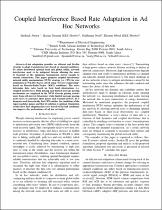JavaScript is disabled for your browser. Some features of this site may not work without it.
- ResearchSpace
- →
- Research Publications/Outputs
- →
- Conference Publications
- →
- View Item
| dc.contributor.author |
Awuor, F

|
|
| dc.contributor.author |
Djouani, K

|
|
| dc.contributor.author |
Noel, G

|
|
| dc.contributor.author |
Olwal, T

|
|
| dc.date.accessioned | 2012-01-05T06:51:19Z | |
| dc.date.available | 2012-01-05T06:51:19Z | |
| dc.date.issued | 2011-09 | |
| dc.identifier.citation | Awuor, F, Djouani, K, Noel, G and Olwal, T. 2011. Coupled interference based rate adaptation in ad hoc networks. IEEE Africon 2011, Livingstone, Zambia, 13-15 September 2011 | en_US |
| dc.identifier.uri | http://hdl.handle.net/10204/5430 | |
| dc.description | IEEE Africon 2011, Livingstone, Zambia, 13-15 September 2011 | en_US |
| dc.description.abstract | Link adaptation provides an efficient and flexible strategy to adapt transmission rates based on channel conditions. To attain distributed optimal local and global utility, network interference need to be mitigated therein allowing the users to transmit at the minimum transmission power enough to sustain connectivity. This paper proposes coupled interference network utility maximization (NUM) strategy (i.e. CIN) for rate adaptation in WLANs that is solved using ”reverse-engineering” based on Karush-Kuhn-Tucker (KKT) conditions. The users determine data rates based on their local observations (i.e. coupled interference). Both pricing and limited message passing mechanisms are employed in the NUM wherein pricing restrict users from self-interest behaviours while limited message passing assist users to announce their prices and transmit powers. It is demonstrated theoretically that CIN satisfies the conditions of the super-modular games and that its solution is optimal. Simulation results show that adapting data rates based on the link conditions can improve the performance of ad hoc networks. | en_US |
| dc.language.iso | en | en_US |
| dc.publisher | IEEE Africon 2011 | en_US |
| dc.relation.ispartofseries | Workflow request;7761 | |
| dc.subject | Link adaptation | en_US |
| dc.subject | Ad Hoc networks | en_US |
| dc.subject | Network utility maximization | en_US |
| dc.subject | Rate adaptation coupled interference | en_US |
| dc.subject | Coupled interference | en_US |
| dc.subject | IEEE Africon 2011 | en_US |
| dc.title | Coupled interference based rate adaptation in ad hoc networks | en_US |
| dc.type | Conference Presentation | en_US |
| dc.identifier.apacitation | Awuor, F., Djouani, K., Noel, G., & Olwal, T. (2011). Coupled interference based rate adaptation in ad hoc networks. IEEE Africon 2011. http://hdl.handle.net/10204/5430 | en_ZA |
| dc.identifier.chicagocitation | Awuor, F, K Djouani, G Noel, and T Olwal. "Coupled interference based rate adaptation in ad hoc networks." (2011): http://hdl.handle.net/10204/5430 | en_ZA |
| dc.identifier.vancouvercitation | Awuor F, Djouani K, Noel G, Olwal T, Coupled interference based rate adaptation in ad hoc networks; IEEE Africon 2011; 2011. http://hdl.handle.net/10204/5430 . | en_ZA |
| dc.identifier.ris | TY - Conference Presentation AU - Awuor, F AU - Djouani, K AU - Noel, G AU - Olwal, T AB - Link adaptation provides an efficient and flexible strategy to adapt transmission rates based on channel conditions. To attain distributed optimal local and global utility, network interference need to be mitigated therein allowing the users to transmit at the minimum transmission power enough to sustain connectivity. This paper proposes coupled interference network utility maximization (NUM) strategy (i.e. CIN) for rate adaptation in WLANs that is solved using ”reverse-engineering” based on Karush-Kuhn-Tucker (KKT) conditions. The users determine data rates based on their local observations (i.e. coupled interference). Both pricing and limited message passing mechanisms are employed in the NUM wherein pricing restrict users from self-interest behaviours while limited message passing assist users to announce their prices and transmit powers. It is demonstrated theoretically that CIN satisfies the conditions of the super-modular games and that its solution is optimal. Simulation results show that adapting data rates based on the link conditions can improve the performance of ad hoc networks. DA - 2011-09 DB - ResearchSpace DP - CSIR KW - Link adaptation KW - Ad Hoc networks KW - Network utility maximization KW - Rate adaptation coupled interference KW - Coupled interference KW - IEEE Africon 2011 LK - https://researchspace.csir.co.za PY - 2011 T1 - Coupled interference based rate adaptation in ad hoc networks TI - Coupled interference based rate adaptation in ad hoc networks UR - http://hdl.handle.net/10204/5430 ER - | en_ZA |






